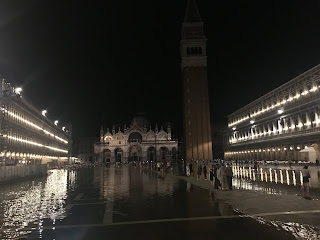the British traffic round about of which there are many! We have not, however, and will never get used to the Cornish lanes which are barely wide enough for one car with tall hedges growing up either side of the car. The tricky part is these single lane roads are two way! That’s right. As some of you know all too well traffic comes both ways on these little lanes. So as you round the corner and come up over the hill, it’s possible you will meet another car coming the opposite direction. After you both come to a quick stop, you have to negotiate who gets to drive forward and who must back up to the last drive way or slightly wider curve in the road in order for your cars to pass. This could require a long back up! Driving has been a bit of a challenge.
Our time in England has been divided into two segments. We began in Oxford. We went to visit our
niece, Julie, whom we haven’t seen since her father’s (my brother's) funeral 8 years ago. It was wonderful to see Julie and to meet her husband, Vikram, and Vikram’s mother who was visiting from India. The three of them had us out to their home twice for a meal and long visit. On the second night we went for a long “country walk” to the local pub in the next village over. The British people love to walk in the country or along the coast and Julie has picked up the custom.
The second segment of our journey took us down to Cornwall where my Grandfather grew up. We stopped off at my cousin Marion’s house in Crediton near Exeter and again made our way to the local pub for dinner. We met Marion 30 years ago when we visited England the first time. You all will remember Marion has been to America twice to visit with us. She remembers with fondness our celebration of Halloween and watching our boys tunnel in the snow in Sturgis.
From Marion’s home we drove down to our rented apartment in the village of Newlyn which is just south of the town of Penzance - you know... where the pirates come from. Actually these days there are apparently drug smugglers in Newlyn! http://www.dailymail.co.uk/news/article-5974811/Police-bomb-squad-close-harbour-storm-yacht-arrest-two-men.html Newlyn is usually a small quiet fishing village of about 6000. The harbor is
filled with fishing trawlers and the homes crawl up the hills that surround the harbor. There is a butcher, bakery, small grocery store, pharmacy, a couple of galleries and some nice seafood restaurants. Our apartment in situated uphill - seriously uphill. We have a switchback driveway with no turn around space at the switch. So we back up the hill about 50 feet and then put it in drive to go the next 50 feet up to our place. We reverse the process on the way down. Apart from the scary driveway, the apartment is lovely and our hosts welcomed us with English cream tea and a plethora of Cornish goodies!
church in Truro with Roger and Cynthia. We met them again, along with Keith and Margaret at the Stithians Show the next day. Stithians, remember, is the little village where grandpa Bolitho was raised with his 6 brothers and sisters. It has a country fair once a year that is similar to our County fairs we have in the states only with a decidedly Cornish twist. They don't have Elephant ears. They have Cornish pasties for fair food. And they have a dog agility show and a display of hounds working with horses for a hunt. Very interesting! It was fun to be at a Stithians event. A few days later Margaret and Keith had us to their home for dinner and today we gathered with Marion and Roger and Cynthia and Gary and his family at Roger's home in Truro for homemade Cornish pasties courtesy of Cynthia. Tomorrow we are gathering the whole clan back in Stithians for a final luncheon out. It has been wonderful to see the English family.
In the in between time, we have done a little exploring of the countryside. One of the most interesting jaunts was a trip to St. Michael’s Mount. We took a ferry over to the Island where there is a beautiful castle that was an addition to the 11th century church and monastery original to the Island. The church still stands. The really cool moment for me, however, was walking back on the causeway that connects the Island to the mainland. The causeway only appears at low tide!
We also took a “country walk” to the next little harbor village called Mousehole (pronouced Mowzel.). We drove over to the beach town of St. Ives that has five beautiful sand beaches! We visited the little church in Gulval once called the Bolitho church which has the Bolitho name plastered under stain glass windows and on monuments and over tombstones in the graveyard. There were also apparently some Bolithos from Newlyn as the name is attached to several civic places here as well. We also made our way to Lands End which is rather commercial these days, but still beautiful! Cousin Marion always reminds me that when you stand at Land’s End and look out to the west, that the next stop is America. That’s what I did yesterday. I looked west toward home.
Our next stop is America. We leave for home in three days time and we're ready! This has been such a great adventure, with many interesting insights and wonderful people. But we are ready to plant our feet on American soil again and see our immediate family again. See you all soon!































